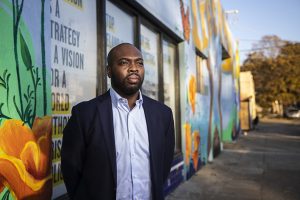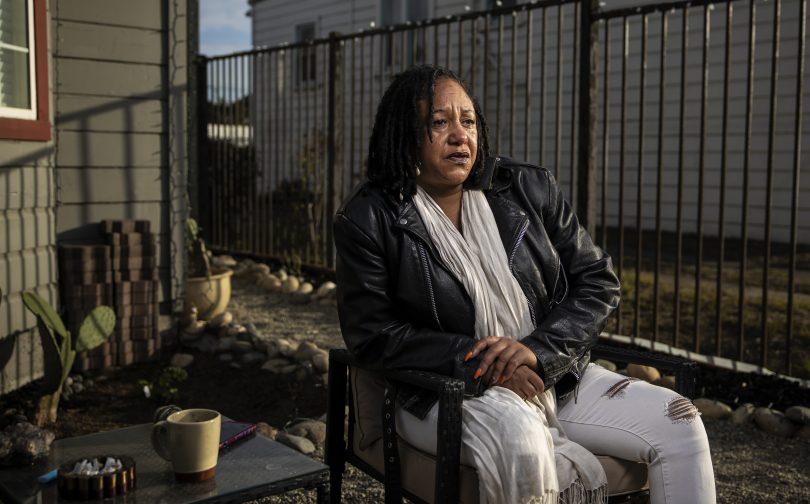by Carly Stern
The last time Liz Zambrano’s ex-husband tried to hurt her, she knew she somehow had to find a path to safety.
While Zambrano’s ex threw household objects at her and her two sons — a computer, then an iron — the threesome fled to the bathroom, and locked themselves inside.
Then Zambrano dialed 911.
She was terrified to call the police, but her fear that her husband would hurt her children outweighed everything.
Zambrano had reasons for her fear of bringing law enforcement into the situation.
Years before, Zambrano, a 41-year-old Latina, called the cops on a previous partner. During that incident, which occurred in 1998, the police had arrested her, not realizing that her batterer’s scratch marks occurred when Zambrano had tried to defend herself.
The bumps and bruises on Zambrano’s head, inflicted by her partner, evidently weren’t visible to the officers.

Domestic violence survivor Liz Zambrano said she was afraid to call the police on her abusive husband. Photo courtesy of Liz Zambrano.
Now, Zambrano worried that if she called the police again all these years later, she might be arrested a second time, or worse, the officers would child welfare, which would place her two kids in foster care.
Forty percent of domestic violence survivors never contact the police. Police intervention can often escalate the violence without disrupting the cycle of abuse, experts said. Survivors of color especially fear involving an institution that too often has delivered damage rather than help.
For decades, advocates, lawyers, and law enforcement have recognized these shortfalls in the system. Yet, disagreements, even among advocates, about how best to prevent domestic violence has often managed to hinder local, state and federal efforts to test alternatives to calling the cops.
In California, however, change may be coming.
In October, Gov. Gavin Newsom signed AB 118, known as the CRISES Act, which will provide funds to create pilot programs for cities or counties to shift certain emergency response calls from law enforcement to community-based organizations. Among the kinds of calls that would be diverted are those involving domestic violence.
State Sen. Sydney Kamlager (D), who authored the bill, and has argued that having community members and trained mental health professionals respond to mental health crises, unhoused individuals, and domestic violence, would reduce violent conflicts with law enforcement.
While some cities and jurisdictions have launched similar efforts, California is the first state to support such experiments statewide.
“It’s the biggest investment in alternative responses that the state has ever seen,” said Cat Brooks, executive director of Justice Teams Network, who advocated for the bill.
Applications from California’s Department of Social Services will open in 2022, once the department establishes parameters of the program. All grants are set to be awarded by January 2023.
Those community-based organizations selected to participate will receive grants of at least $250,000 over three years, and will be required to partner with a local government organization of their choosing to implement programs.
Partner agencies can include health, mental health, or social service providers, among others. Parameters are flexible so that groups can tailor their approaches for their individual communities. For example, some may focus on neighborhoods in a city or county that have become hotspots, while others may serve specific communities of color where the need is great.

Marc Philpart of PolicyLink’s Alliance for Boys and Men of Color. Photo by Martin do Nascimento/Resolve Magazine
“We wanted to explore a variety of different approaches before trying to scale something across California’s 58 counties and 500 cities,” said Marc Philpart, principal Coordinator of PolicyLink’s Alliance for Boys and Men of Color, which was one of more than 10 organizations that sponsored the bill.
Interrupting cycles of violence
Supporters of the bill said they hope community organizations interested in applying for the funds will bring a range of voices and stakeholders to the table.
Such voices could include domestic violence survivors, people who have inflicted violence, health care providers, community-based activists, academics, or law enforcement officials—although some justice advocates disagree on the extent of police involvement.
According to Brooks it is particularly essential to bring survivors into the conversation, in order to address such questions as: “If you had a number that you could call besides law enforcement, what would you want it to look like, feel like, sound like?”
Aylaliyah Assefa, a domestic violence survivor who lives in Sacramento, said she wished she could have had access to someone equipped to navigate emotional trauma rather than interrogate her when she finally called the police during a fight with an abusive partner.
Assefa recommended that first responders receive training on how to approach survivors of abuse so they can assess the people around them before launching into questioning.
“The first thing we want is a safe haven away from the hurt…not further criminalization on top of what we’ve been through,” she said.
Organizations applying for the grants will also have the opportunity to expand their focus to create intervention programs for people who cause harm, Philpart said.
“If you look at the domestic violence response system right now, it is exclusively focused on the person who is suffering harm. And that is important,” he said. “But I think we need another layer in order to really prevent, and address, and interrupt, cycles of violence.”
When Zambrano called law enforcement the second time, she didn’t get arrested and her kids weren’t taken away. Nevertheless, she wished the police could have done more for her. When police arrived and couldn’t get her ex-husband to leave the couple’s one-bedroom apartment, the officers suggested that Zambrano and her children leave for three days instead and file a protective order.
Zambrano and her sons packed their things for a few days, but the protective order took a month to be served. In the meantime, she had to take time off from work as she was shuffled between police stations and courts.
Looking back, Zambrano said she would have liked to have had holistic support to help her navigate the process ,so she didn’t have to do it alone.
Now Zambrano is connected with Strength United, a trauma recovery center she calls a “one-stop family justice center,” because it offers various services, along with counseling and general support.
Looking back, she said she would have likely called Strength United, rather than the police, had she known they existed.
These days, Zambrano is vocal in her community about her experiences. She is proud, she said, of the ways that she’s “trying to break the cycle [of domestic violence] within my family.”
“I use [my voice] …so that I can hopefully try to help people, help our community, let them know that they’re not alone.”
‘Allow them to dream’
In California, some alternative approaches to addressing domestic violence already exist on a smaller scale. Now, experts say, the state funding will allow such organizations to expand their work.
“I’m hopeful that groups who are interested in responding to 911 calls related to domestic violence, or intimate partner violence, will step up and really craft a proposal that will allow them to dream,” said Senator Kamlager.
In addition, prospective groups can look to organizations across the country that are tackling adjacent issues.
Brooks, who also is a survivor of domestic violence, points to the MH First Programs launched by the Anti Police-Terror Project in Sacramento and Oakland in 2020, which has a phone hotline that responds to psychiatric emergencies, the need for substance use support, and other mental health crises during hours when other professionals aren’t available.
The city of Eugene, Ore. has been operating a mobile crisis intervention program called Crisis Assistance Helping Out On The Streets (CAHOOTS) for roughly three decades. The city funds CAHOOTS through the Eugene Police Department, but the program is staffed by medics and mental health workers from a community health clinic, not law enforcement.
Police dispatch CAHOOTS teams to respond to non-emergency calls that require interventions such as crisis counseling, conflict resolution, referrals to resources and transportation to services. The teams do not, however, handle crimes in progress, violence or life-threatening emergencies.
Meanwhile, Aleese Moore-Orbih, executive director of the California Partnership to End Domestic Violence, points to the “Promotora de Salud” model, in which community members are trained as peer or lay educators to share information about health equity and other issues. This approach has also been used to educate community members about domestic violence.
A pathway to safety
As pilot projects take off, policymakers will look for ways to measure their success. Metrics could include declines in arrests or officer-involved shootings, said Sen. Kamlager. They also involve changes that are harder to measure, such as, “Did a participant find a pathway to safety? Did violence re-occur? Did the participant get to determine their pathway?” Brooks added.
Success also means these programs will help survivors who otherwise might have tried to escape abuse on their own.
Those opposed to transitioning away from police responses have argued that domestic violence situations can be deadly and that responders who are not police officers don’t have adequate training to protect survivors and themselves. Even within national efforts to shift funding away from police budgets, some advocates shy away from supporting new approaches when it comes to domestic violence.
“When we start talking about alternative responses to police, people carve out intimate partner violence and say, ‘it’s too dangerous, too problematic. We have to keep sending police there, but we can send other people to other kinds of situations,’” said Leigh Goodmark, director of the Gender Violence Clinic at the University of Maryland Carey School of Law.
Yet, Goodmark argues that the current system isn’t protecting many survivors anyway, especially those who are people of color, and that the time has come to try something different.
It’s unreasonable for police to quickly and effectively judge which person is the victim or who is telling the truth, said Sen. Kamlager. Under California law, officers must identify and arrest the “primary aggressor” when both people show injury.
“We have placed so many issues on the shoulders of law enforcement: all of the things that we don’t quite understand, that have become too complicated for us to solve easily,” said Sen. Kamlager. “They have shown us repeatedly that they do not have the capacity to manage those issues.”
Some officers acknowledge the complexity of domestic violence cases and the limitations law enforcement faces in addressing them. Abdul Pridgen, chief of the San Leandro Police Department, said police intervention cannot disrupt the cycle of abuse.
Pridgen is interested in alternative approaches to mitigate certain issues that commonly lead to violence. But, he said, it’s “imperative that law enforcement partners are in the discussion early on.”
The way Cat Brooks sees it, the new California pilot could restore agency to people who have experienced violence.
“My hope for survivors is that we won’t just be walking wounded, that we’ll actually get the help that we need for ourselves, our children, our partners,” she said.
Brooks points out that new methods don’t mean the police are going away. If a survivor decides that calling 911 is her pathway to safety, she gets to decide.
“Survivors will have control over the path,” Brooks said.
Top photo shows Cat Brooks, executive director of Justice Teams Network, outside her home in Oakland, Calif. At 19, Brooks was severely beaten by her husband but when the police intervened, Brooks was taken to jail rather than her husband. Photo by Martin do Nascimento / Resolve Magazine
This story was produced in partnership with the California Health Report.


Unfortunately, the very stringent laws passed in the 1980’s intended to protect victim’s of domestic violence had unintended consequences. Officer’s were no longer able to use their discretion on how to handle each situation they were called to. The laws mandated that if there was ANY evidence of injury on a person, the other person must be arrested. Oftentimes, when both parties had visible injuries, no matter how slight, both parties were arrested. I’m not sure how this solved anything. It’s no wonder that victim’s are reluctant to call the police !
Person can inflict himself visible injuries, it doesn’t mean it was at this situation. The problem is that the police doesn’t really care who to take. and they called it “taking seriously.” police has delivered damage rather than help.
It is very difficult to approach domestic violence due to uncertainty of who the victim is. The offenders might have injuries, but still be perpetrators who want to pass themselves for victims.